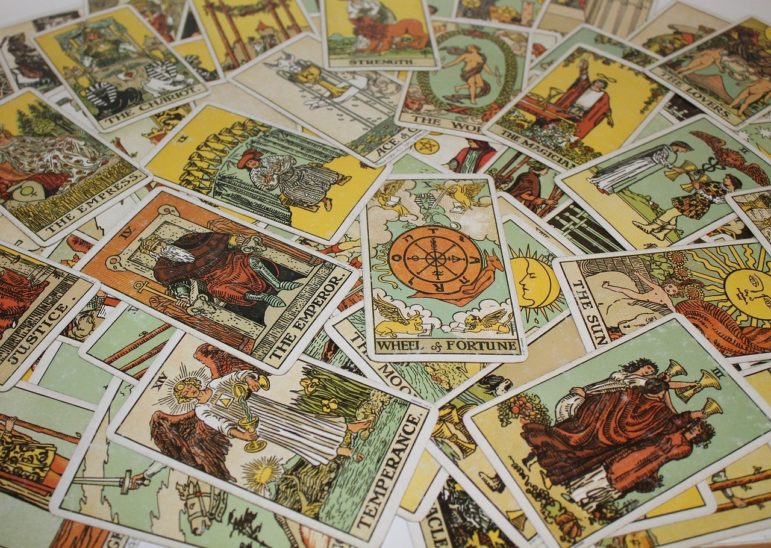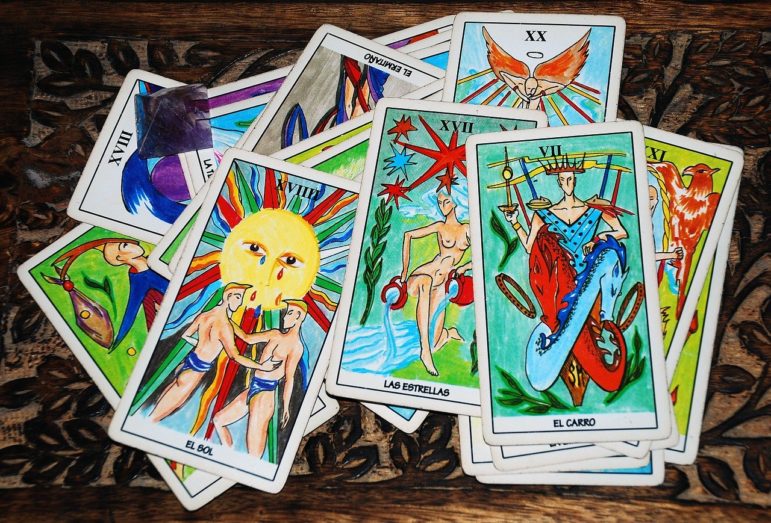
The first wave of cards came from my friends. “Send me the decks you aren’t using,” I asked, and a scattershot of packages appeared over the next couple of weeks. They came from Seattle, St. Louis, Florida, two floors down, from friends I had known for years and friends I had only met once. They all sent me their castoffs. The decks were as disparate as the people. One was obviously a labor of love, printed too thick in a sticky cardstock with grainy photos in place of illustrations. Another, somewhat shockingly, was a classic and fairly valuable deck that I had last seen splayed under the hand of a fortune-telling mannequin at House On The Rock.
“I just can’t read with it,” my friend said, when I reached out to ask him why he’d sent it. “At least you’ll use it.”
I have wondered for a long time what makes a tarot deck “click” for someone. My first deck, a pocket-sized Rider-Waite-Smith (RWS) that my partner took exactly one look at before it fell to me, was entirely opaque when I first picked it up. I didn’t know the symbols they featured or how they were used, and only the small folded paper included in the box offered any insight. I worried over it, put it down, came back to scour the nine-word summaries of each card and try again. I attempted a Celtic cross based on the inch-high diagram, a feat which has meant that my standard spread is just slightly misaligned from everyone else’s I’ve ever met.
I learned the symbols through repetition and became fond of them through a long period of familiarity. When I eventually got another deck, I assumed it would follow different rules. After all, I knew what a tarot deck was by then, the familiar blues and yellows of the cards. This new deck was so much larger, its images unrelated to anything I recognized. I expected a different window into the world.
What I got instead was a different voice. That’s as close as I have ever come to describing the experience of reading with a new deck. For me, it is like being introduced to a new friend that speaks a familiar language with a personal and nuanced inflection. In getting to know a deck, I feel out what sort of advice it’s likely to give, what it is most interested in talking about. The logical part of me knows that this is the richness of old symbols, interpreted by an artist and then reinterpreted in my hands by my querent and I. The Pagan in me wonders if it’s something else, a spirit specific to the deck itself. I certainly act as if that’s the case, reaching out in the same way that I reach out to certain friends depending on their interests and my mood.
I’ve thought about that a lot in the last few weeks, as I pull from discarded decks. I’ve wondered if a spirit that may or may not exist, that has never been born, can die.

A collection of tarot cards from the Rider-Waite-Smith deck [AlbanyColley, Pixabay]
For me, it started with a Kickstarter notification that Seven Dane Asmund had a new project on the way. I’d backed the last one they had worked on, the Caretaker’s Normal Tarot, and finally acquired a deck that in no way resembled my beloved (and at this point much-revered) RWS. I had become so familiar with the same sets of courts and arcana that this deck, with its many dead kings and questing knights, was unexpectedly difficult to master, the way my first deck had been. I was still learning its unique language – but I was interested, and I had an old fascination with travelers of all sorts, so The Alleyman’s Tarot seemed like it would be worth a look, at the least.
I looked. I wasn’t entirely sure what I was looking at. The Kickstarter, which was already funded by the time I found it, seemed like the sort of sprawling and ambitious project which sweeps its creator along in it – a tarot deck composed of single cards licensed from other decks, themed around a mystical fiction known as The Alleyman. The story was that this deck was a found object, recreated from a unique deck belonging to The Alleyman themself. It had 57 non-standard cards in addition to the usual 78 and everything from poker chips to cigar boxes in accompanying ephemera. I couldn’t imagine a world in which the creator was able to pull it off, but dagnabbit, I liked their style. I backed it, and wished them well, and went about my business.
The idea stuck with me, though. I flipped through my own decks, looking at the cards that most resonated with me and the ones that, well, were also there. Wouldn’t it be something, I thought, to have a deck that was entirely using my language?
I ran my finger along the edge of one Ace of Pentacles, thinking about the deck I would build around it – and dismissed the thought immediately. I found myself petting it as if to reassure it, and tried not to feel too foolish. I wouldn’t take apart the decks I used – but what about the ones I didn’t? They were gathering dust in a closet, most of them bought because I had enjoyed a handful of cards and then found the deck unpleasant or unintelligible. I wondered how many of my friends had similar stockpiles.
It went against so much of the tradition I had internalized about how to use tarot. Plenty of readers I knew and trusted were vehemently against a deck made out of the parts of others, much less one that added new or non-standard cards. Still, the idea lingered. Was the tradition useful, I wondered? Was a ramshackle deck doomed to be merely a collection of cards? Or was there an opportunity here to create something new?

A collection of tarot cards with Spanish titles [trasmitiendoconocimien, Pixabay]
It was months before I realized that I was not the only person to have this thought. In that time I’d cobbled together some of a deck, using most of an RWS as the backbone. Its previous owner had taken several cards for specific spells and I, filling those gaps, thought maybe this was a spell as well. I had a stack of decks with missing pieces, piled like scrap metal in a corner, but the thing beneath my hands was starting to look like something recognizable. I was careful not to shuffle it, careful not to do anything resembling a reading. It wasn’t finished. I didn’t want to wake it up yet.
While the deck which had inspired it battled every sort of delay a project could have, mine also looked as though it would never be finished. There were specific cards I wanted, versions that had defined how I thought of those cards – but was I really willing to buy an entire deck just for its pieces? That seemed like a very fast path towards a very expensive final product – and what would I do with the growing discard pile in the corner?
The answer was to trade them. While I was rummaging in my friends’ magical dumpsters, the fan community around The Alleyman’s Tarot had exploded. A week ago, after carefully cataloging the cards I’d opted not to use, I posted them in the Facebook group set up for others building their own decks. These were the castoffs of castoffs, cards that I thought nobody would be interested in. I’ve been bartering them ever since.

A miscellaneous assortment of tarot cards [Glegle, Pixabay]
The combination of tarot, bartering, and international mail is a heady one. I feel Hermes in it, laughing as I throw myself into a new kind of enterprise. For a week I’ve played at running a small business. I’ve sorted and spread stacks of cards across the floor, each labeled with the name of an internet stranger. I’ve looked through folders of art, choosing the ones I like best without much of a plan. When they get here, I’ve thought to myself, then I’ll see what I’m working with. Then I’ll breathe some life into this project of mine.
Today I learned that the Alleyman’s deck is finally on its way, traveling across the world to me at last. It seems fitting – I have mailed more envelopes in the last two days than in the last year and soon everything will arrive at once. Empress, Hierophant, Two of Swords in North Carolina. Seven of Swords, Three of Cups, Eight of Pentacles in Australia. In return I will get dozens of cards – but in the meantime all of them are somewhere between us, traveling, crossing over other envelopes on their way to other bargains. I think that’s a spell in and of itself, a great weaving that is bringing new decks into being across the world.
I wonder if mine will have a spirit that speaks to me.
The Wild Hunt always welcomes guest submissions. Please send pitches to eric@wildhunt.org.
The views and opinions expressed by our diverse panel of columnists and guest writers represent the many diverging perspectives held within the global Pagan, Heathen and polytheist communities, but do not necessarily reflect the views of The Wild Hunt Inc. or its management.
The Wild Hunt is not responsible for links to external content.
To join a conversation on this post:
Visit our The Wild Hunt subreddit! Point your favorite browser to https://www.reddit.com/r/The_Wild_Hunt_News/, then click “JOIN”. Make sure to click the bell, too, to be notified of new articles posted to our subreddit.
